Development of a High-Performance Composite Mortar for Ultra-High-Strength Preplaced Aggregate Concrete-Filled Steel Tubes (PACFSTs)
Abstract
1. Introduction
2. Experimental Program
2.1. Materials
2.2. Experimental Test
2.3. Mix Design
3. Test Results and Discussion
3.1. Influence of the Sand-to-Binder Ratio
3.1.1. Workability
3.1.2. Mechanical Properties
3.1.3. Volume Stability
3.2. Preparation of Mixes with a Low Water-to-Binder Ratio
3.2.1. Workability
3.2.2. Mechanical Properties
3.2.3. Volume Stability
3.3. Influence of the Expansive Agent
3.3.1. Workability
3.3.2. Mechanical Properties
3.3.3. Volume Stability
3.4. Preparation of Ultra-High-Strength Preplaced Aggregate Concrete-Filled Steel Tubes
3.4.1. Mechanical Properties
3.4.2. Volume Stability
4. Conclusions
- (1)
- The influence of the sand-to-binder ratio on the fluidity of the composite mortar is more significant when the ratio is relatively small. However, when the sand-to-binder ratio becomes excessively large, the fluidity no longer improves, and the paste strength decreases.
- (2)
- Based on an appropriate amount of mineral admixtures, by optimizing the sand-to-binder ratio to 1.2, reducing the water-to-binder ratio to 0.28, and supplementing with 6% expansive agent to compensate for shrinkage, a high-performance composite mortar can be produced. Its 28-day compressive strength can reach 88.3 MPa or higher, while also exhibiting excellent fluidity and volume stability.
- (3)
- Using a high-performance composite mortar as the paste material, ultra-high-strength preplaced aggregate concrete-filled steel tubes (PACFSTs) can be prepared. Compared to conventional C100 concrete-filled steel tubes, this PAC system has higher strength and elastic modulus, reduced volume shrinkage, and offers good economic benefits and environmental adaptability. It is suitable for engineering fields such as bridges, tunnels, and high-rise buildings.
- (4)
- While this study demonstrates significant improvements in the mechanical performance and shrinkage resistance, further research should focus on long-term durability under aggressive environmental conditions (e.g., marine exposure, freeze–thaw cycles) and full-scale validation to assess thermal cracking risks and constructability. Additionally, lifecycle cost analysis and carbon footprint assessment are needed to evaluate the economic and environmental viability of this system for large-scale applications.
Author Contributions
Funding
Institutional Review Board Statement
Informed Consent Statement
Data Availability Statement
Acknowledgments
Conflicts of Interest
References
- Lv, J.; Zhou, T.; Du, Q.; Li, K.; Jin, L. Research on the bond behavior of preplaced aggregate concrete-filled steel tube columns. Materials 2020, 13, 300. [Google Scholar] [CrossRef] [PubMed]
- Lin, S.; Liu, F.; Bai, Q. Bond Behavior of Concrete-Filled Steel Tube with Molybdenum Tailing. Int. J. Steel Struct. 2024, 24, 354–365. [Google Scholar] [CrossRef]
- Wang, X.; Li, X.; Zhong, Y.; Li, H.; Wang, J. Properties and microstructure of an interfacial transition zone enhanced by silica fume in concrete prepared with coal gangue as an aggregate. ACS Omega 2023, 9, 1870–1880. [Google Scholar] [CrossRef] [PubMed]
- Abendeh, R.; Salman, D.; Al Louzi, R. Experimental and numerical investigations of interfacial bond in self-compacting concrete-filled steel tubes made with waste steel slag aggregates. Dev. Built Environ. 2022, 11, 100080. [Google Scholar] [CrossRef]
- Hu, B.; Li, X.; Cheng, W. Interface Transition Zone in Coal Gangue Aggregate Concrete Reinforced by Phosphorus Slag: Macroscopic Properties and Microstructure. J. Mater. Civ. Eng. 2024, 36, 04024310. [Google Scholar] [CrossRef]
- Feng, P.; Li, Z.; Zhang, S.; Yang, J. Steel slag aggregate concrete filled-in FRP tubes: Volume expansion effect and axial compressive behaviour. Constr. Build. Mater. 2022, 318, 125961. [Google Scholar] [CrossRef]
- Zhang, Z.; Zhang, B.; Yan, P. Comparative study of effect of raw and densified silica fume in the paste, mortar and concrete. Constr. Build. Mater. 2016, 105, 82–93. [Google Scholar] [CrossRef]
- Noh, H.; Kim, D. Effects of combined nanoparticles on dynamic strength of ultra-high-performance fiber-reinforced concrete. J. Build. Eng. 2024, 96, 110508. [Google Scholar]
- Mo, L.; Deng, M.; Tang, M.; Al-Tabbaa, A. MgO expansive cement and concrete in China: Past, present and future. Cem. Concr. Res. 2014, 57, 1–12. [Google Scholar] [CrossRef]
- Lv, J.; Zhou, T.; Li, K. Investigation and application of a new low-carbon material (preplaced aggregate concrete) in concrete-filled steel tube stub columns. Sustainability 2020, 12, 1768. [Google Scholar] [CrossRef]
- Li, W.; Jiang, B.; Gu, S.; Yang, X.; Shaikh, F. Experimental study on the shear behavior of grout-infilled specimens and micromechanical properties of grout-rock interface. J. Cent. South Univ. 2022, 29, 1686–1700. [Google Scholar] [CrossRef]
- Tang, H.; Pishro, A.; Zhao, Y.; Jiang, X. Structural behavior of a novel preplaced aggregate concrete-filled steel tube stub columns. J. Constr. Steel Res. 2025, 227, 109367. [Google Scholar] [CrossRef]
- Zhou, X.; Bai, S.; Zhang, Y.; Xie, L.; Zhou, X. Designing prepacked aggregate concrete for improved mechanical properties and its field application in constructing steel tube concrete. Sci. Rep. 2024, 14, 14613. [Google Scholar] [CrossRef] [PubMed]
- Hou, C.; Han, L.; Liang, Z.; Hu, C. Performance of concrete-encased CFST subjected to low-velocity impact: Shear resistance analysis. Int. J. Impact Eng. 2021, 150, 103798. [Google Scholar] [CrossRef]
- Sakino, K.; Nakahara, H.; Morino, S.; Nishiyama, I. Behavior of centrally loaded concrete-filled steel-tube short columns. J. Struct. Eng. 2004, 130, 180–188. [Google Scholar] [CrossRef]
- Al Zand, A.; Badaruzzaman, W.; Mutalib, A.; Hilo, S. The enhanced performance of CFST beams using different strengthening schemes involving unidirectional CFRP sheets: An experimental study. Eng. Struct. 2016, 128, 184–198. [Google Scholar] [CrossRef]
- Coo, M.; Pheeraphan, T. Effect of sand, fly ash, and coarse aggregate gradation on preplaced aggregate concrete studied through factorial design. Constr. Build. Mater. 2015, 93, 812–821. [Google Scholar] [CrossRef]
- Cheng, Y.; Liu, S.; Zhu, B.; Liu, R.; Wang, Y. Preparation of preplaced aggregate concrete and experimental study on its strength. Constr. Build. Mater. 2019, 229, 116847. [Google Scholar] [CrossRef]
- Ayanlere, S.; Ajamu, S.; Odeyemi, S.; Ajayi, O.; Kareem, M. Effects of water-cement ratio on bond strength of concrete. Mater. Today Proc. 2023, 86, 134–139. [Google Scholar] [CrossRef]
- Duan, P.; Shui, Z.; Chen, W.; Shen, C. Effects of metakaolin, silica fume and slag on pore structure, interfacial transition zone and compressive strength of concrete. Constr. Build. Mater. 2013, 44, 1–6. [Google Scholar] [CrossRef]
- Hosan, A.; Shaikh, F.; Sarker, P.; Aslani, F. Nano-and micro-scale characterisation of interfacial transition zone (ITZ) of high volume slag and slag-fly ash blended concretes containing nano SiO2 and nano CaCO3. Constr. Build. Mater. 2021, 269, 121311. [Google Scholar] [CrossRef]
- Nguyen, D.; Lin, W.; Liao, W. Long-term creep and shrinkage behavior of concrete-filled steel tube. Materials 2021, 14, 295. [Google Scholar] [CrossRef] [PubMed]
- Muthu, M.; Kumar, B.; Sadowski, Ł. Experimental study on self-compacting concrete-filled steel tube samples containing shrinkage-controlling admixtures. J. Build. Eng. 2023, 70, 106465. [Google Scholar] [CrossRef]
- Zhang, J. Recent advance of MgO expansive agent in cement and concrete. J. Build. Eng. 2022, 45, 103633. [Google Scholar] [CrossRef]
- Tran, N.; Gunasekara, C.; Law, D.; Houshyar, S.; Setunge, S.; Cwirzen, A. A critical review on drying shrinkage mitigation strategies in cement-based materials. J. Build. Eng. 2021, 38, 102210. [Google Scholar] [CrossRef]
- Meng, W.; Khayat, K. Improving flexural performance of ultra-high-performance concrete by rheology control of suspending mortar. Compos. Part B Eng. 2017, 117, 26–34. [Google Scholar] [CrossRef]
- Najeeb, Z.; Mosaberpanah, M. Mechanical and durability properties of modified High-Performance mortar by using cenospheres and Nano-Silica. Constr. Build. Mater. 2023, 362, 129782. [Google Scholar] [CrossRef]
- El-Mir, A.; Nehme, S.; Assaad, J. Effect of binder content and sand type on mechanical characteristics of ultra-high performance concrete. Arab. J. Sci. Eng. 2022, 47, 13021–13034. [Google Scholar] [CrossRef]
- Teng, L.; Wei, J.; Khayat, K.; Assaad, J. Effect of competitive adsorption between specialty admixtures and superplasticizer on structural build-up and hardened property of mortar phase of ultra-high-performance concrete. Cem. Concr. Compos. 2023, 141, 105130. [Google Scholar] [CrossRef]
- Teng, L.; Addai-Nimoh, A.; Khayat, K. Effect of lightweight sand and shrinkage reducing admixture on structural build-up and mechanical performance of UHPC. J. Build. Eng. 2023, 68, 106144. [Google Scholar] [CrossRef]
- Ran, X.; Ou, W.; Li, P. Strength compatibility and optimization of grout and coarse aggregate in two-stage ultra-high performance concrete. J. Build. Eng. 2025, 106, 112623. [Google Scholar] [CrossRef]
- Ye, B.; Zhang, Y.; Han, J.; Pan, P. Effect of water to binder ratio and sand to binder ratio on shrinkage and mechanical properties of High-strength Engineered Cementitious Composite. Constr. Build. Mater. 2019, 226, 899–909. [Google Scholar] [CrossRef]
- Zanjad, N.; Pawar, S.; Nayak, C. Use of fly ash cenosphere in the construction Industry: A review. Mater. Today Proc. 2022, 62, 2185–2190. [Google Scholar] [CrossRef]
- Wu, J.; Lu, Z.; Chen, Y.; Ghiassi, B.; Shi, W.; Li, B. Mechanical properties and cracking behaviour of lightweight engineered geopolymer composites with fly ash cenospheres. Constr. Build. Mater. 2023, 400, 132622. [Google Scholar] [CrossRef]
- ASTMC1240-20; Standard Specification for Silica Fume Used in Cementitious Mixtures, Designation: C1240. ASTM International: West Conshohocken, PA, USA, 2020.
- JTGE30-2005; Test Methods of Cement and Concrete for Highway Engineering. China Communications Press: Beijing, China, 2005.
- GB/T17671-2021; Method of Testing Cements—Determination of Strength (ISO Method). China Standard Press: Beijing, China, 2021.
- GB/T50081-2002; Standard Test Methods for Mechanical Properties of Concrete. China Architecture & Building Press: Beijing, China, 2002.
- GB/T50082-2024; Standard for Test Methods of Long-Term Performance and Durability of Ordinary Con-Crete. China Architecture & Building Press: Beijing, China, 2024.
- Das, K.; Lam, E.; Jang, J. Effects of modified binders on flowability of grout and properties of preplaced aggregate concrete. J. Build. Eng. 2023, 68, 106235. [Google Scholar] [CrossRef]
- Li, S.; Sha, F.; Liu, R.; Zhang, Q.; Li, Z. Investigation on fundamental properties of microfine cement and cement-slag grouts. Constr. Build. Mater. 2017, 153, 965–974. [Google Scholar] [CrossRef]
- Han, F.; Pu, S.; Zhou, Y.; Zhang, H.; Zhang, Z. Effect of ultrafine mineral admixtures on the rheological properties of fresh cement paste: A review. J. Build. Eng. 2022, 51, 104313. [Google Scholar] [CrossRef]
- Piasta, W.; Zarzycki, B. The effect of cement paste volume and w/c ratio on shrinkage strain, water absorption and compressive strength of high performance concrete. Constr. Build. Mater. 2017, 140, 395–402. [Google Scholar] [CrossRef]
- Mendes, A.; Sanjayan, J.; Gates, W.; Collins, F. The influence of water absorption and porosity on the deterioration of cement paste and concrete exposed to elevated temperatures, as in a fire event. Cem. Concr. Compos. 2012, 34, 1067–1074. [Google Scholar] [CrossRef]
- Mo, L.; Fang, J.; Hou, W.; Ji, X.; Yang, J.; Fan, T.; Wang, H. Synergetic effects of curing temperature and hydration reactivity of MgO expansive agents on their hydration and expansion behaviours in cement pastes. Constr. Build. Mater. 2019, 207, 206–217. [Google Scholar] [CrossRef]
- GB 50936-2014; Technical Code for Concrete Filled Steel Tubular Structures. Administration of Quality Supervision, Inspection and Quarantine of the People’s Republic of China. Ministry of Housing and Urban-Rural Development of the People’s Republic of China: Beijing, China, 2014.
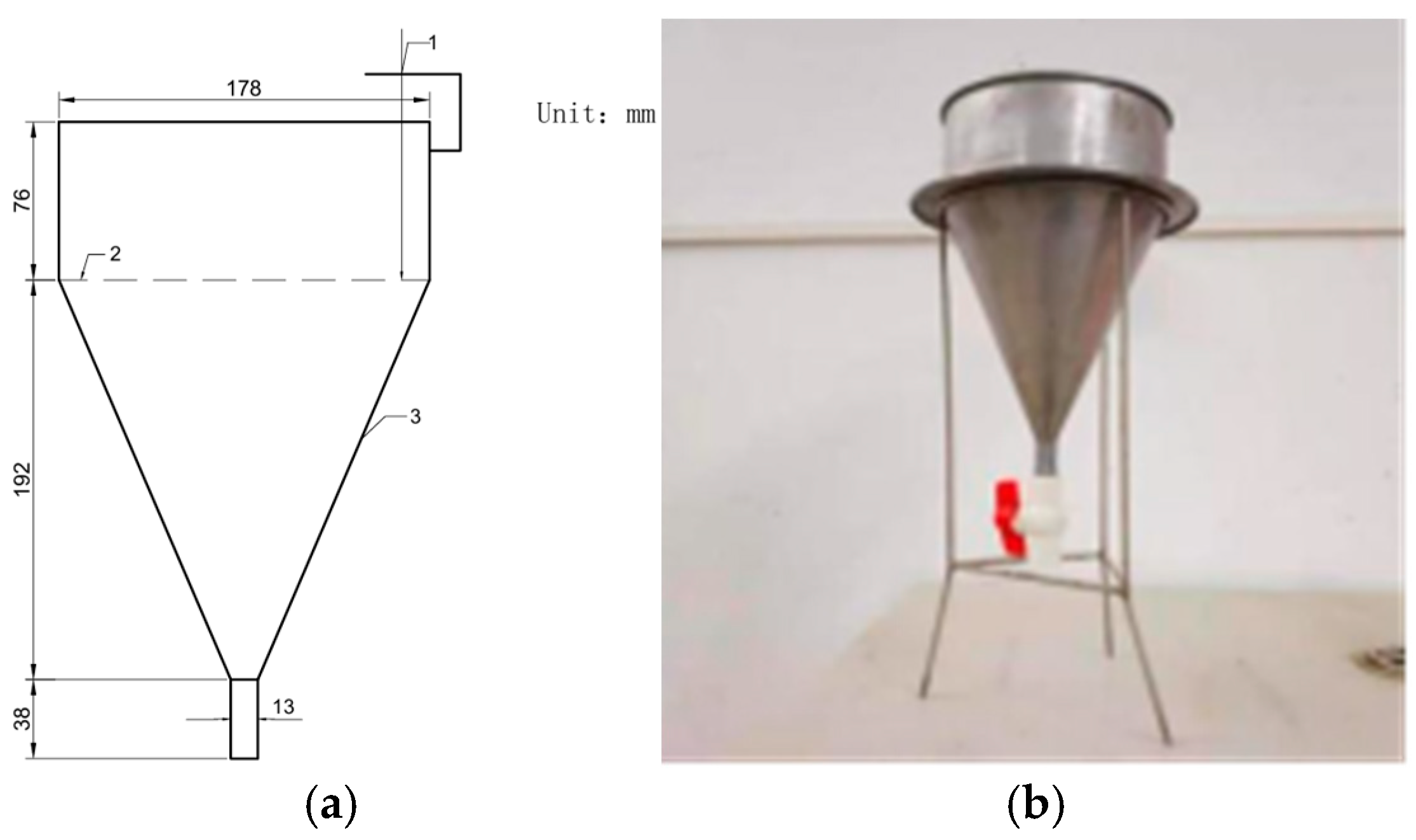
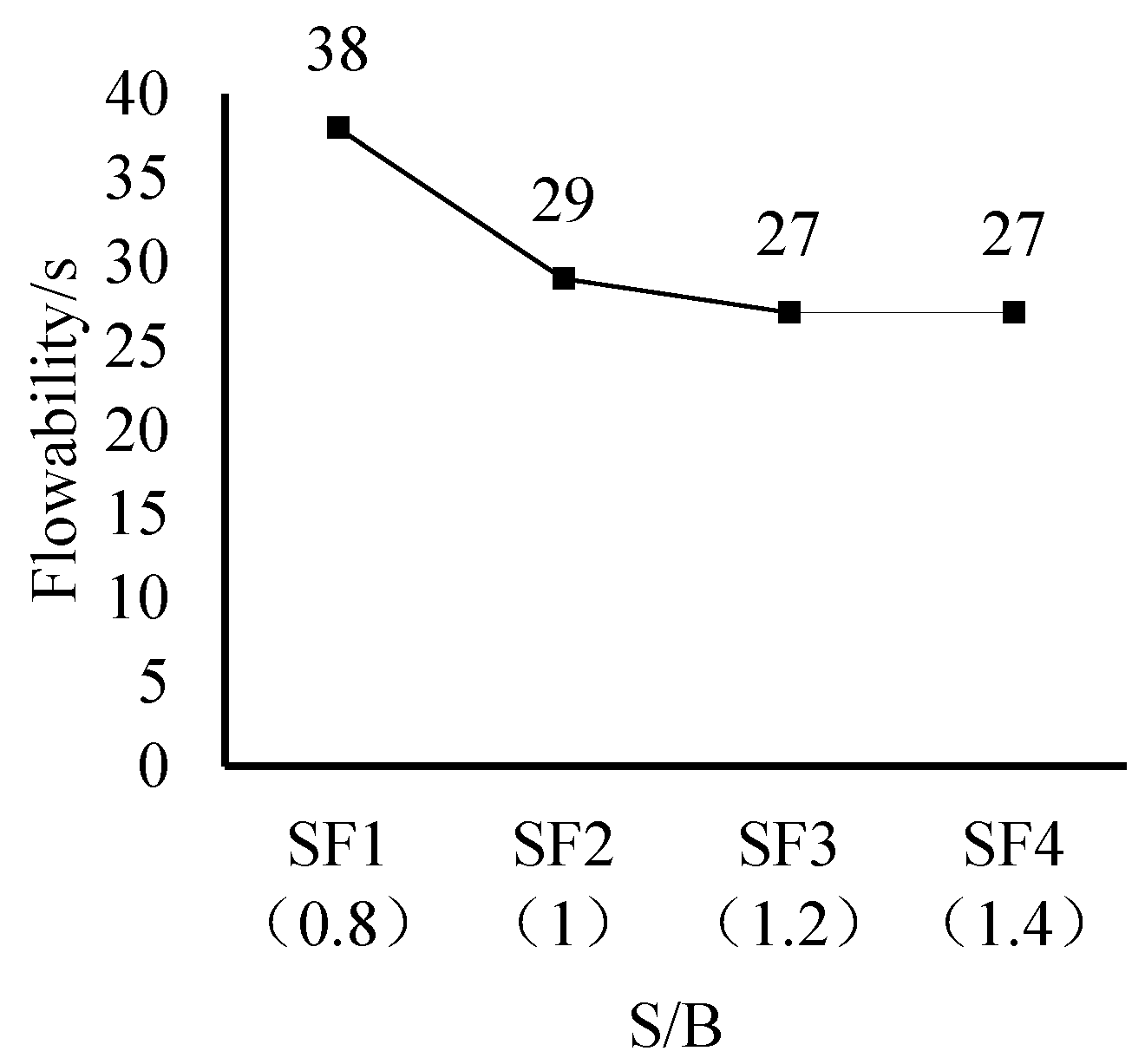

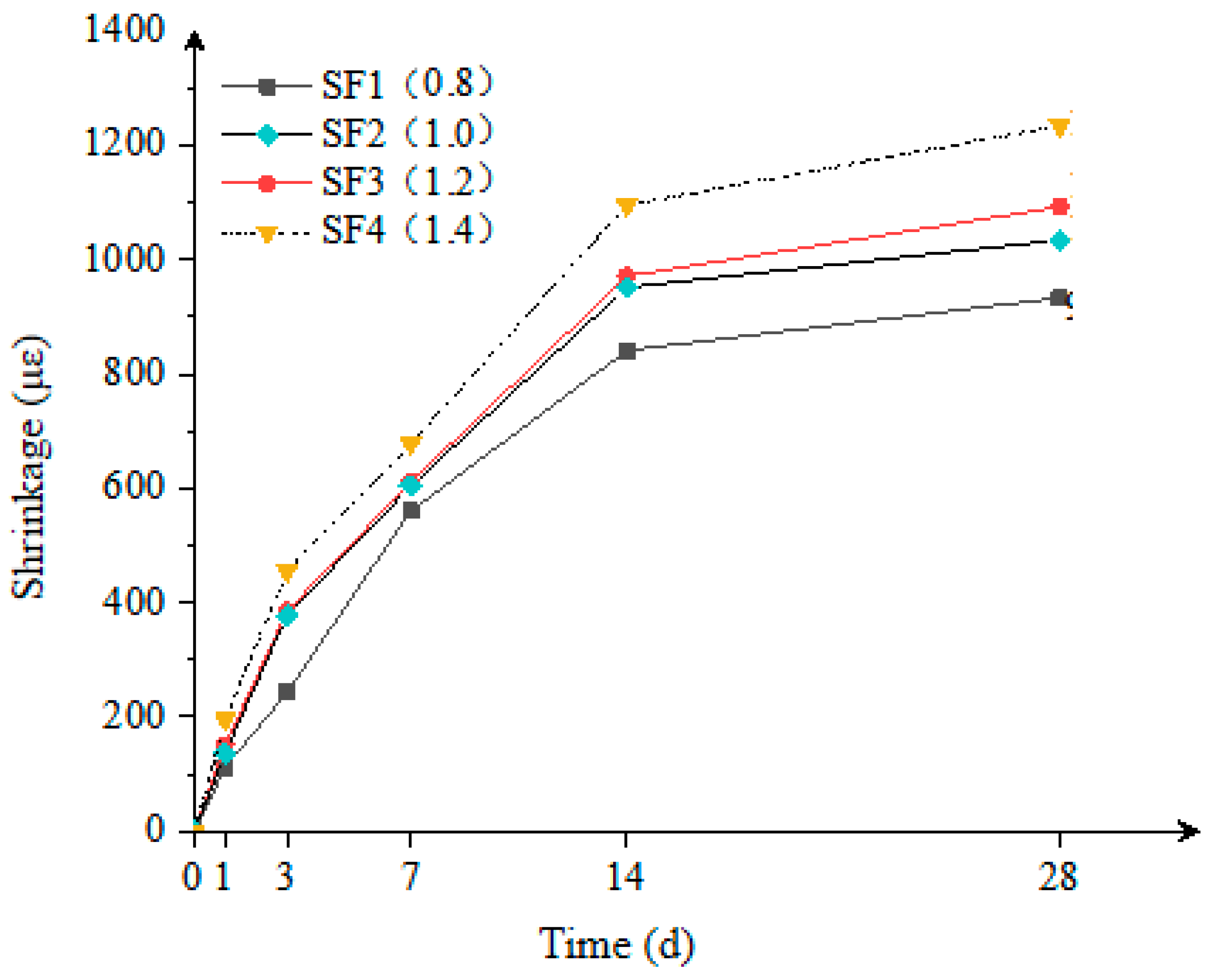
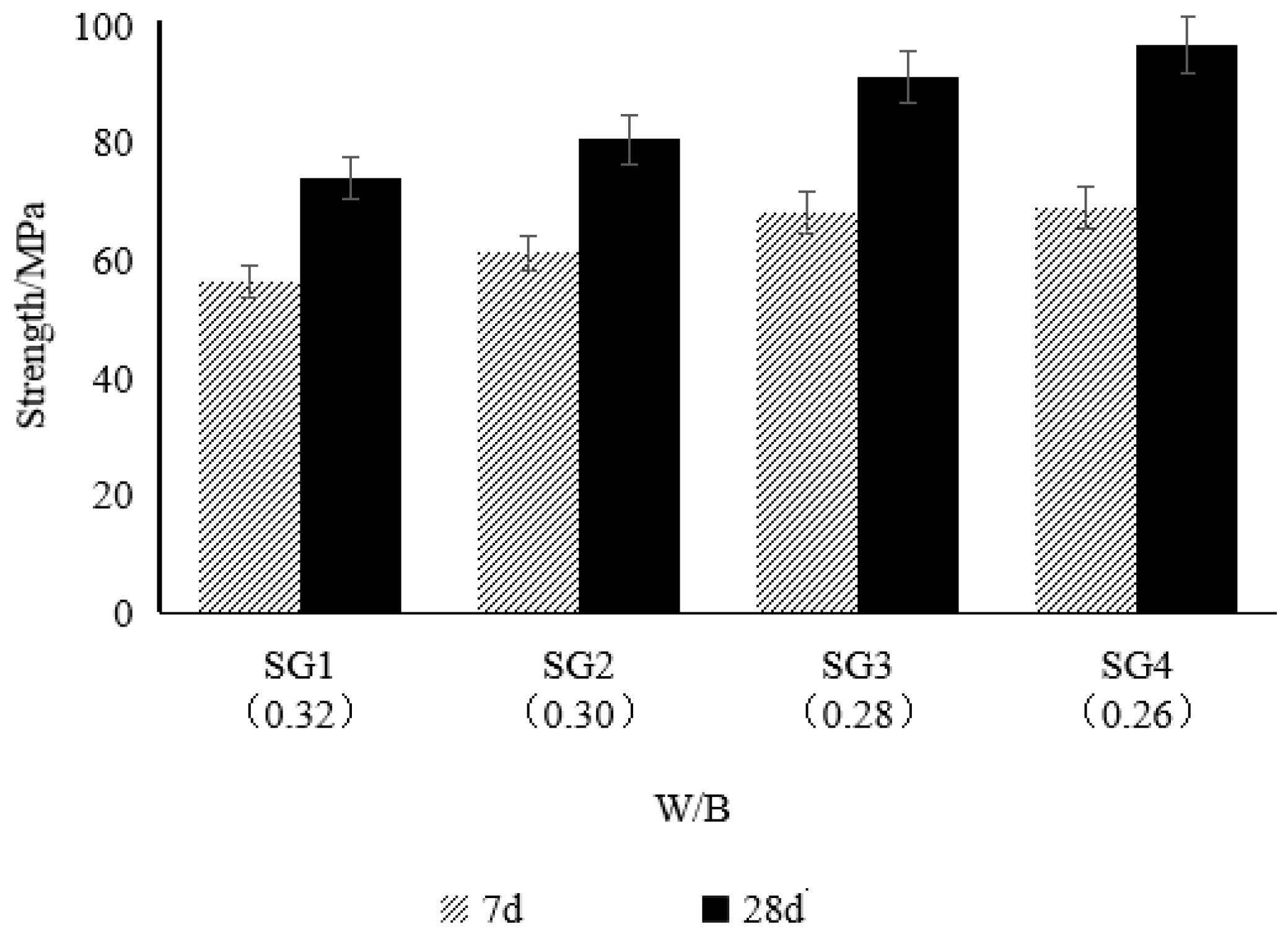

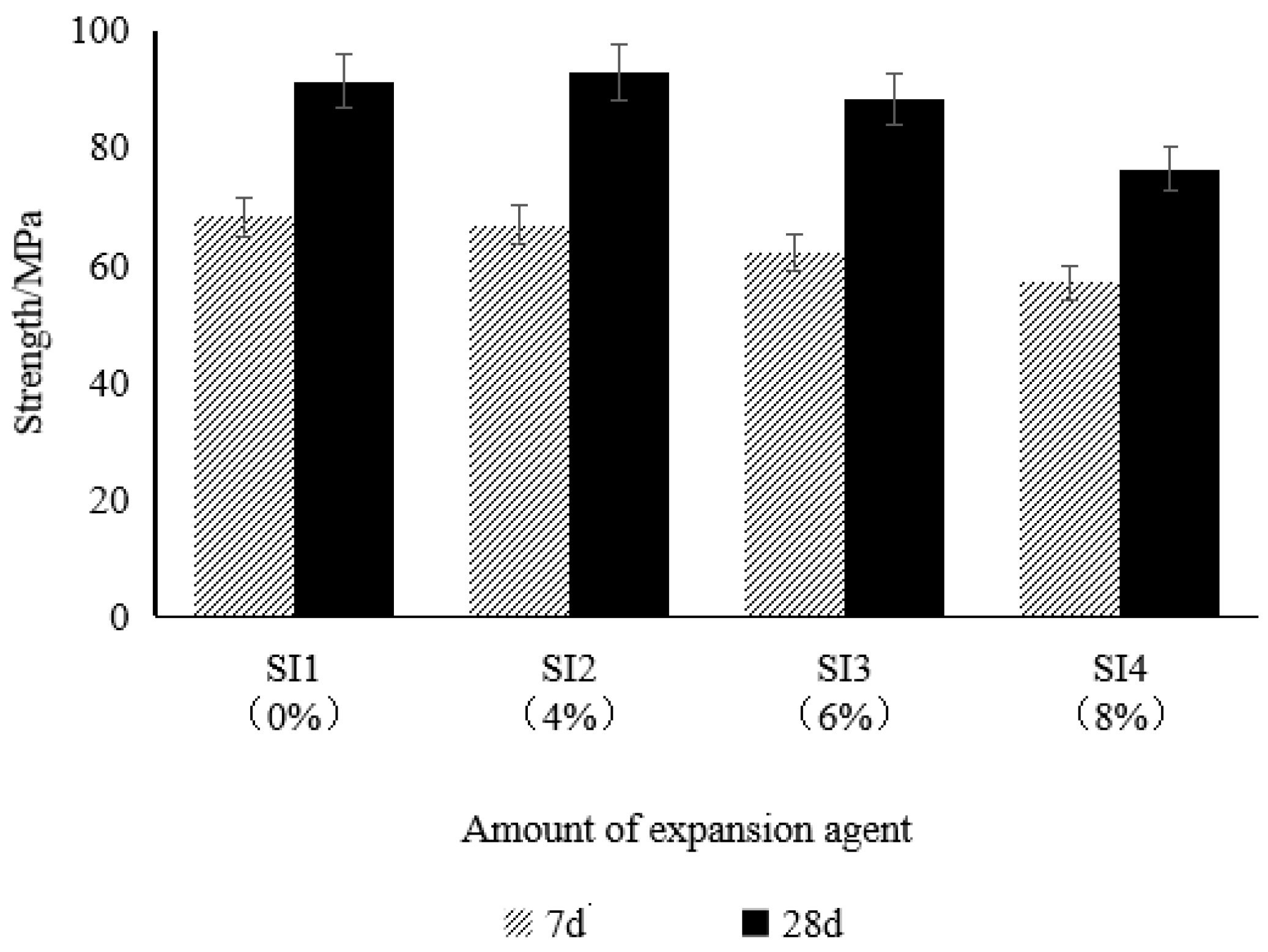
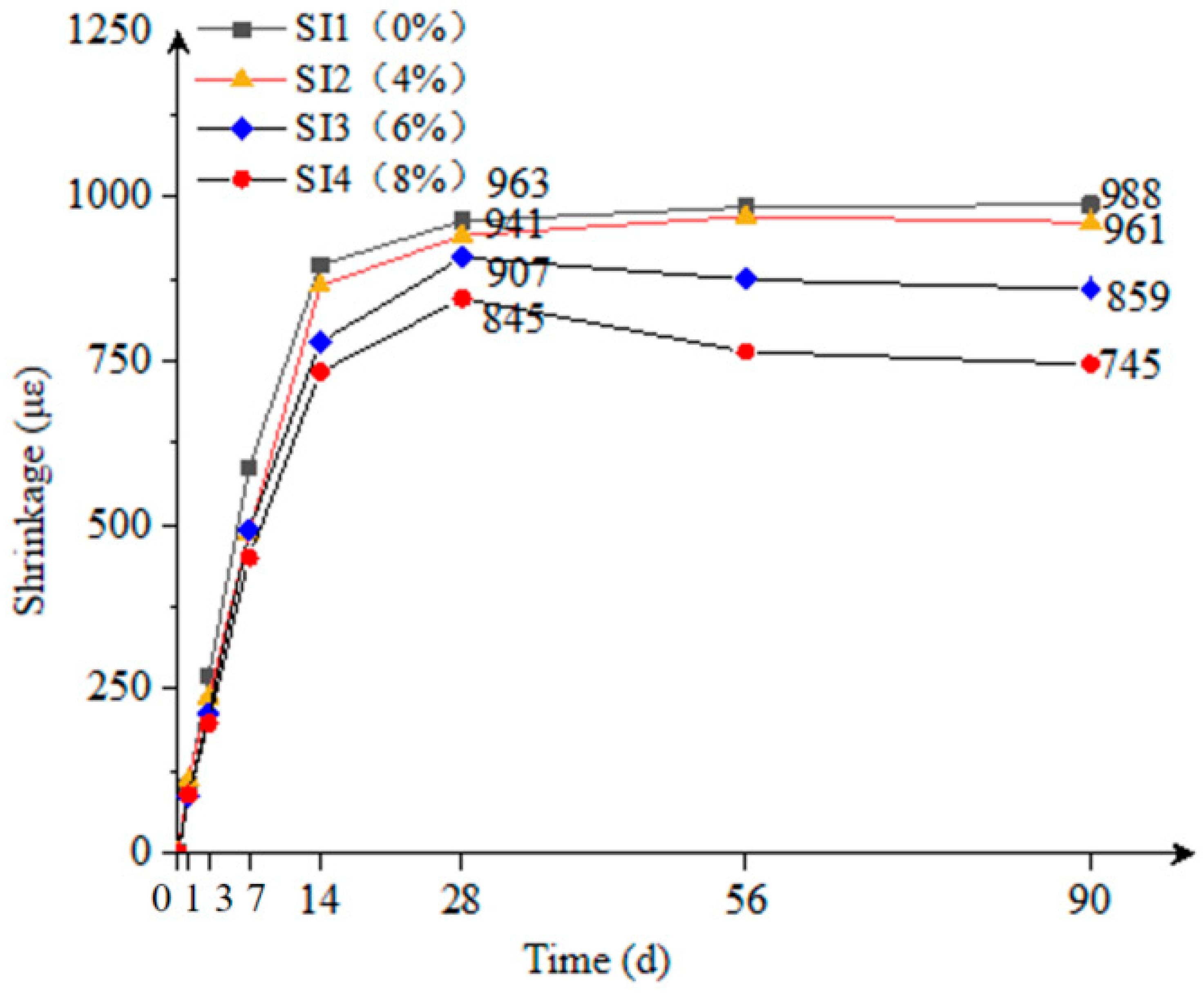


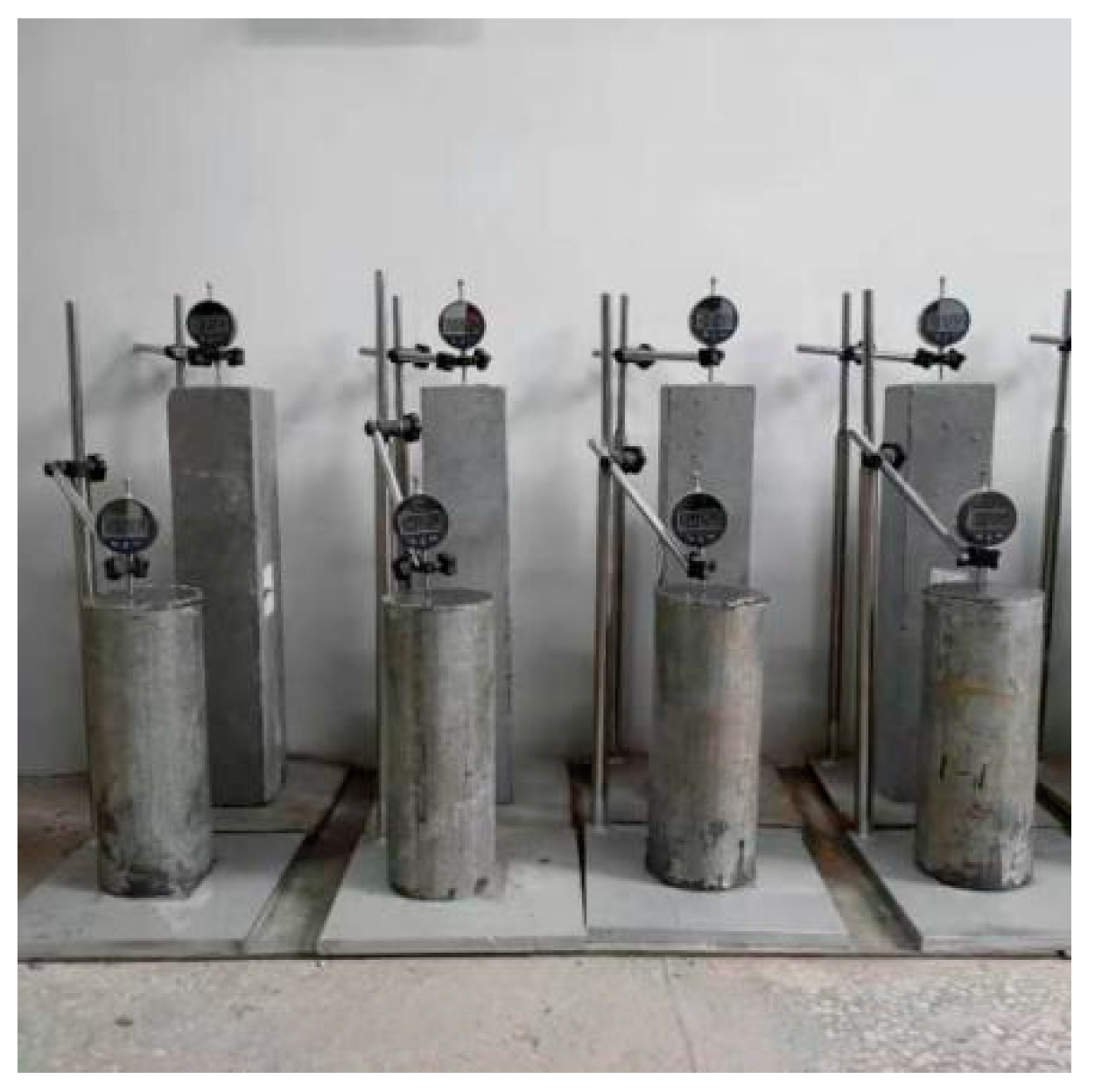

| Strength Class | Specific Surface Area, m2·kg−1 | Flexural Strength, MPa | Compressive Strength, MPa | ||
|---|---|---|---|---|---|
| 3 d | 28 d | 3 d | 28 d | ||
| P·O 42.5 | 320 | 5.9 | 5.4 | 28.6 | 46.1 |
| P·O 52.5 | 364 | 7.2 | 10.6 | 35.1 | 57.1 |
| Setting Time, min | Restricted Expansion Rate, % | Compressive Strength, MPa | |||
|---|---|---|---|---|---|
| Initial Setting | Final Setting | 7 d in Water | 28 d in Air | 7 d | 28 d |
| 168 | 215 | 0.026 | 0.012 | 29.3 | 41.6 |
| ID | S/B | Cementitious Materials, kg·m−3 | Flowability | Mechanical Property | ||||||
|---|---|---|---|---|---|---|---|---|---|---|
| Cement | FA | SF | Sand | Water | Expansive Agent | Efflux Time | 7 d Compressive Strength, MPa | 28 d Compressive Strength, MPa | ||
| SF1 | 0.8 | 605 | 170 | 70 | 1055 | 317 | 9 | 38 s | 54.3 | 68.2 |
| SF2 | 1 | 670 | 190 | 75 | 935 | 281 | 9 | 29 s | 57.8 | 71.1 |
| SF3 | 1.2 | 730 | 200 | 80 | 840 | 303 | 10 | 27 s | 61.2 | 80.5 |
| SF4 | 1.4 | 770 | 210 | 85 | 760 | 320 | 10 | 27 s | 64.7 | 82.6 |
| ID | S/B | Design Weight | Cementitious Materials, kg·m−3 | Flowability | Mechanical Property | ||||||
|---|---|---|---|---|---|---|---|---|---|---|---|
| Cement | FA | SF | Sand | Water | WRA | Efflux Time | 7 d Compressive Strength, MPa | 28 d Compressive Strength, MPa | |||
| SG1 | 0.32 | 2150 | 720 | 200 | 80 | 830 | 320 | 10 | 27 s | 56.4 | 73.9 |
| SG2 | 0.30 | 2150 | 730 | 200 | 80 | 840 | 303 | 10 | 34 s | 61.2 | 80.5 |
| SG3 | 0.28 | 2250 | 770 | 215 | 85 | 890 | 276 | 16 | 35 s | 68.1 | 91.1 |
| SG4 | 0.26 | 2250 | 770 | 215 | 90 | 895 | 280 | 22 | 45 s | 69 | 96.5 |
| ID | Expansive Agent | Cementitious Materials, kg·m−3 | Flowability | Mechanical Property | |||||||
|---|---|---|---|---|---|---|---|---|---|---|---|
| Cement | FA | SF | Sand | Expansive Agent | Water | WRA | Efflux Time | 7 d Compressive Strength, MPa | 28 d Compressive Strength, MPa | ||
| SI1 | 0% | 770 | 215 | 85 | 890 | 0 | 276 | 16 | 35 s | 68.1 | 91.1 |
| SI2 | 4% | 770 | 215 | 85 | 890 | 45 | 276 | 22 | 36 s | 66.7 | 92.8 |
| SI3 | 6% | 770 | 215 | 85 | 890 | 65 | 276 | 28 | 33 s | 62.2 | 88.3 |
| SI4 | 8% | 770 | 215 | 85 | 890 | 85 | 264 | 32 | 35 s | 56.9 | 76.3 |
| Class | ID | Mix Design, kg·m−3 | |||||||
|---|---|---|---|---|---|---|---|---|---|
| Cement | FA | SF | Expansive Agent | Water | Sand | Stone | WRA | ||
| C100 PACFST | PAC1 | 267 | 75 | 30 | 23 | 96 | 309 | 1737 | 7.6 |
| C100 CFST | HSC2 | 480 | 100 | 90 | 0 | 126 | 704 | 1013 | 16.8 |
Disclaimer/Publisher’s Note: The statements, opinions and data contained in all publications are solely those of the individual author(s) and contributor(s) and not of MDPI and/or the editor(s). MDPI and/or the editor(s) disclaim responsibility for any injury to people or property resulting from any ideas, methods, instructions or products referred to in the content. |
© 2025 by the authors. Licensee MDPI, Basel, Switzerland. This article is an open access article distributed under the terms and conditions of the Creative Commons Attribution (CC BY) license (https://creativecommons.org/licenses/by/4.0/).
Share and Cite
Zhao, Y.; Zhou, X.; Zhang, Y.; Li, S. Development of a High-Performance Composite Mortar for Ultra-High-Strength Preplaced Aggregate Concrete-Filled Steel Tubes (PACFSTs). Materials 2025, 18, 2218. https://doi.org/10.3390/ma18102218
Zhao Y, Zhou X, Zhang Y, Li S. Development of a High-Performance Composite Mortar for Ultra-High-Strength Preplaced Aggregate Concrete-Filled Steel Tubes (PACFSTs). Materials. 2025; 18(10):2218. https://doi.org/10.3390/ma18102218
Chicago/Turabian StyleZhao, Yicheng, Xiaojun Zhou, Yingda Zhang, and Sheng Li. 2025. "Development of a High-Performance Composite Mortar for Ultra-High-Strength Preplaced Aggregate Concrete-Filled Steel Tubes (PACFSTs)" Materials 18, no. 10: 2218. https://doi.org/10.3390/ma18102218
APA StyleZhao, Y., Zhou, X., Zhang, Y., & Li, S. (2025). Development of a High-Performance Composite Mortar for Ultra-High-Strength Preplaced Aggregate Concrete-Filled Steel Tubes (PACFSTs). Materials, 18(10), 2218. https://doi.org/10.3390/ma18102218





